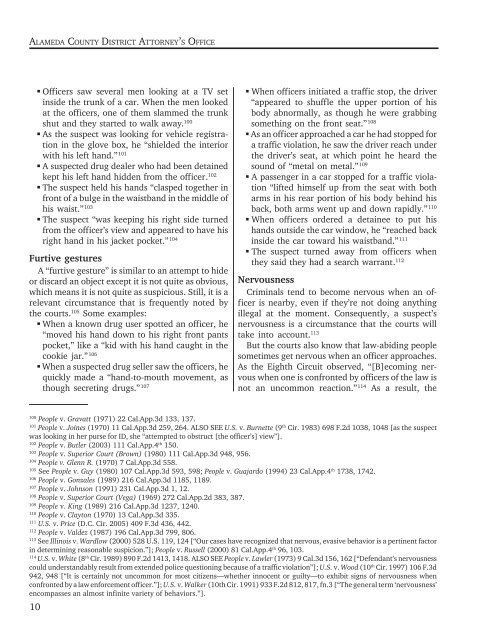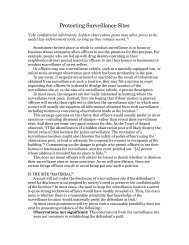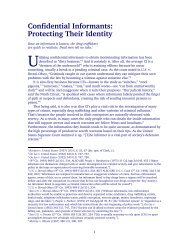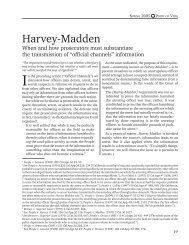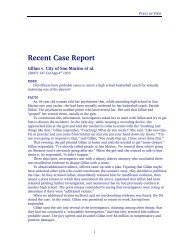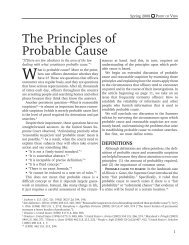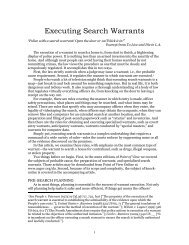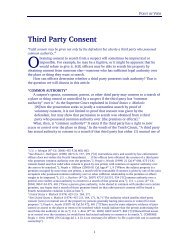PC TO ARREST.pmd - Alameda County District Attorney's Office
PC TO ARREST.pmd - Alameda County District Attorney's Office
PC TO ARREST.pmd - Alameda County District Attorney's Office
You also want an ePaper? Increase the reach of your titles
YUMPU automatically turns print PDFs into web optimized ePapers that Google loves.
ALAMEDA COUNTY DISTRICT AT<strong>TO</strong>RNEY’S OFFICE<br />
10<br />
� <strong>Office</strong>rs saw several men looking at a TV set<br />
inside the trunk of a car. When the men looked<br />
at the officers, one of them slammed the trunk<br />
shut and they started to walk away. 100<br />
� As the suspect was looking for vehicle registration<br />
in the glove box, he “shielded the interior<br />
with his left hand.” 101<br />
� A suspected drug dealer who had been detained<br />
kept his left hand hidden from the officer. 102<br />
� The suspect held his hands “clasped together in<br />
front of a bulge in the waistband in the middle of<br />
his waist.” 103<br />
� The suspect “was keeping his right side turned<br />
from the officer’s view and appeared to have his<br />
right hand in his jacket pocket.” 104<br />
Furtive gestures<br />
A “furtive gesture” is similar to an attempt to hide<br />
or discard an object except it is not quite as obvious,<br />
which means it is not quite as suspicious. Still, it is a<br />
relevant circumstance that is frequently noted by<br />
the courts. 105 Some examples:<br />
� When a known drug user spotted an officer, he<br />
“moved his hand down to his right front pants<br />
pocket,” like a “kid with his hand caught in the<br />
cookie jar.” 106<br />
� When a suspected drug seller saw the officers, he<br />
quickly made a “hand-to-mouth movement, as<br />
though secreting drugs.” 107<br />
� When officers initiated a traffic stop, the driver<br />
“appeared to shuffle the upper portion of his<br />
body abnormally, as though he were grabbing<br />
something on the front seat.” 108<br />
� As an officer approached a car he had stopped for<br />
a traffic violation, he saw the driver reach under<br />
the driver’s seat, at which point he heard the<br />
sound of “metal on metal.” 109<br />
� A passenger in a car stopped for a traffic violation<br />
“lifted himself up from the seat with both<br />
arms in his rear portion of his body behind his<br />
back, both arms went up and down rapidly.” 110<br />
� When officers ordered a detainee to put his<br />
hands outside the car window, he “reached back<br />
inside the car toward his waistband.” 111<br />
� The suspect turned away from officers when<br />
they said they had a search warrant. 112<br />
Nervousness<br />
Criminals tend to become nervous when an officer<br />
is nearby, even if they’re not doing anything<br />
illegal at the moment. Consequently, a suspect’s<br />
nervousness is a circumstance that the courts will<br />
take into account. 113<br />
But the courts also know that law-abiding people<br />
sometimes get nervous when an officer approaches.<br />
As the Eighth Circuit observed, “[B]ecoming nervous<br />
when one is confronted by officers of the law is<br />
not an uncommon reaction.” 114 As a result, the<br />
100 People v. Gravatt (1971) 22 Cal.App.3d 133, 137.<br />
101 th People v. Joines (1970) 11 Cal.App.3d 259, 264. ALSO SEE U.S. v. Burnette (9 Cir. 1983) 698 F.2d 1038, 1048 [as the suspect<br />
was looking in her purse for ID, she “attempted to obstruct [the officer’s] view”].<br />
102 th People v. Butler (2003) 111 Cal.App.4 150.<br />
103 People v. Superior Court (Brown) (1980) 111 Cal.App.3d 948, 956.<br />
104 People v. Glenn R. (1970) 7 Cal.App.3d 558.<br />
105 th See People v. Guy (1980) 107 Cal.App.3d 593, 598; People v. Guajardo (1994) 23 Cal.App.4 1738, 1742.<br />
106 People v. Gonzales (1989) 216 Cal.App.3d 1185, 1189.<br />
107 People v. Johnson (1991) 231 Cal.App.3d 1, 12.<br />
108 People v. Superior Court (Vega) (1969) 272 Cal.App.2d 383, 387.<br />
109 People v. King (1989) 216 Cal.App.3d 1237, 1240.<br />
110 People v. Clayton (1970) 13 Cal.App.3d 335.<br />
111 U.S. v. Price (D.C. Cir. 2005) 409 F.3d 436, 442.<br />
112 People v. Valdez (1987) 196 Cal.App.3d 799, 806.<br />
113 See Illinois v. Wardlow (2000) 528 U.S. 119, 124 [“Our cases have recognized that nervous, evasive behavior is a pertinent factor<br />
in determining reasonable suspicion.”]; People v. Russell (2000) 81 Cal.App.4th 96, 103.<br />
114 th U.S. v. White (8 Cir. 1989) 890 F.2d 1413, 1418. ALSO SEE People v. Lawler (1973) 9 Cal.3d 156, 162 [“Defendant’s nervousness<br />
could understandably result from extended police questioning because of a traffic violation”]; U.S. v. Wood (10th Cir. 1997) 106 F.3d<br />
942, 948 [“It is certainly not uncommon for most citizens—whether innocent or guilty—to exhibit signs of nervousness when<br />
confronted by a law enforcement officer.”]; U.S. v. Walker (10th Cir. 1991) 933 F.2d 812, 817, fn.3 [“The general term ‘nervousness’<br />
encompasses an almost infinite variety of behaviors.”].


